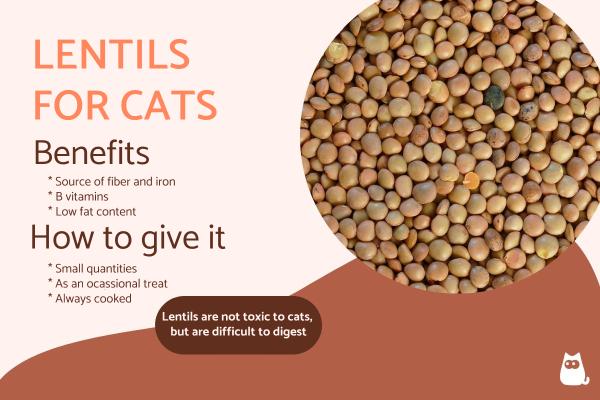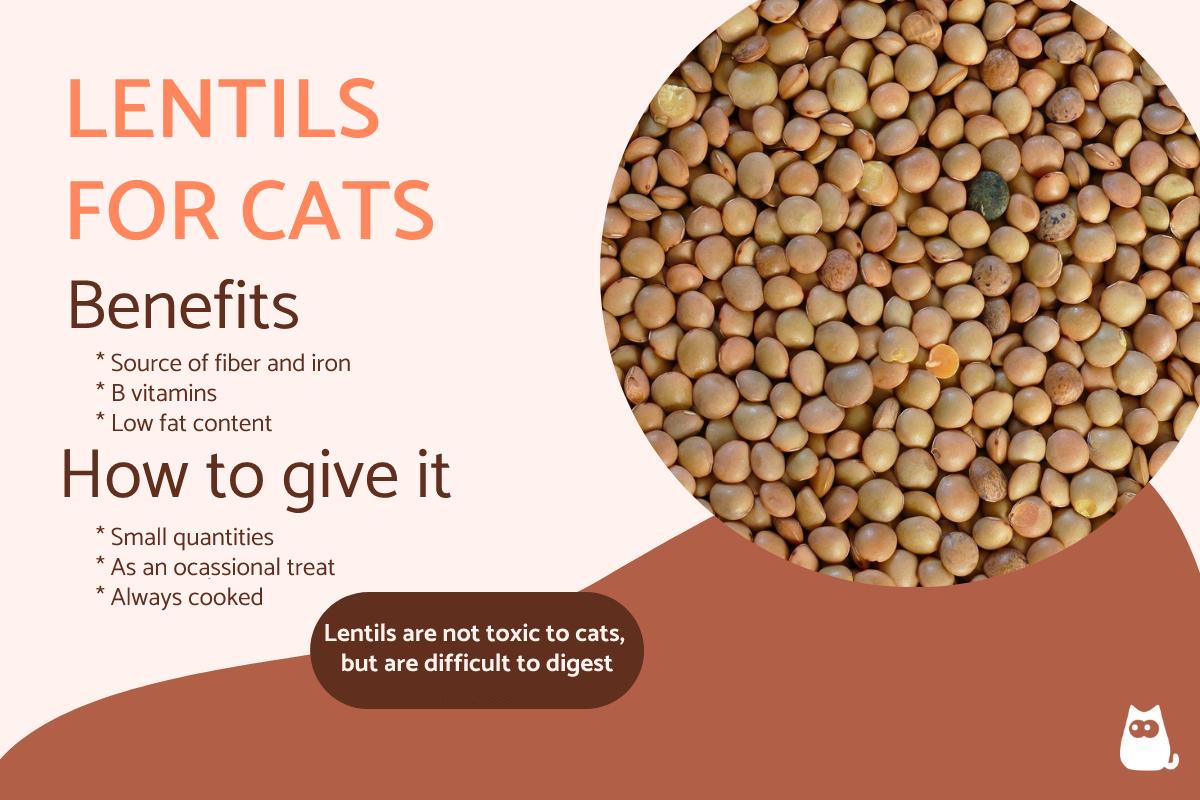Can Cats Eat Lentils?



See files for Cats
Lentils are special types of grains that come from a plant in the legume family. Lentils are eaten all over the world because they bring many benefits to human consumption. Cats will eat anything that looks or feels like food. But as responsible pet owners, you should always be careful about anything you feed your cat. Especially if it's not an animal product. As you may know, cats' nutritional needs are different from ours, as they are exclusively carnivores.
The following AnimalWised article explains if cats can eat lentils and how you can give them.
Are lentils good for cats?
Lentil or Lens culinaris is an annual herbaceous plant belonging to the Papilionaceae family. Lentil consists of branched, flexible and ribbed stems up to 40 cm long with elongated leaves and white flowers with purple veins. The fruit is in a small pod with two or three round brown seeds.
Cats are among the strict carnivores. They need the proteins contained in animal tissues to provide themselves with all essential macro- and micronutrients and, despite their high biological value, do not absorb them from other sources such as carbohydrates or lentil proteins.
Technically, cats can eat lentils. Lentils are low-calorie treats that your cat can sometimes eat and in small amounts. Even though cats do not need some nutrients lentils provide, they can occasionally enjoy the taste and texture of these round beans. Before giving lentils to your cat, check with your veterinarian to make sure your cat can eat them.
Most importantly, always feed lentils to your cat in moderation. Lentils should never replace your cat's main diet. This is the only way you can avoid some common side effects associated with plant-based foods for cats, which we will discuss later on.
If you want to know more about what cats can eat, do not miss this other article, where we offer you a complete guide to cat nutrition.
Benefits of lentils for cats
Lentils are a very nutritious and popular food in the Mediterranean diet. The main ingredients are protein and carbohydrates in the form of starch, especially the former. The protein content is so high because they contain nodules in the roots, which are home to bacteria of the genus Rhizobium that convert atmospheric nitrogen into usable organic nitrogen.
Nevertheless, the proteins they contain lack methionine, an essential amino acid, but in combination with cereals such as corn or oats, the need for this amino acid can be met as if they were meat proteins. However, this is not true for our cats. They require amounts of other essential amino acids found in meat, such as arginine and taurine, and also from fatty tissues of animal origin to provide a source of arachidonic acid.
In general, lentils contain the following nutritional benefits, although they are not necessary for a cat's diet, their intake can provide it with the following nutrients:
- Dietary fiber
- B-complex vitamins
- Magnesium
- Zinc
- Iron
- Match
- Potassium
- Carbohydrates
- Proteins
- Low fat content
Due to its high mineral content, it has a positive effect on the general health of the cat. It fights fatigue and anemia, allows the binding of calcium and phosphorus in the bones, keeps hair and skin healthy and contains antioxidant properties that prevent aging.
Although it is rich in carbohydrates, they are complexed in the form of starch, so they are released more slowly, reducing the rise in glucose and insulin that is dangerous for diabetic cats. In addition, the fiber it contains helps stabilize blood sugar levels by lowering them.
If you want to learn more about diabetes in cats, do not miss the following article where we explain everything you need to know about diabetes in cats, including symptoms, diagnosis, and care.

How to give lentils to your cat
Cats can eat lentils in small amounts and not frequently, as long as they like them, and they do not cause problems.
There are numerous ways to prepare lentils for human consumption. However, there is only one method when it comes to preparing lentils for cats.
- First, it is recommended to soak the lentils overnight. This helps to denature the antinutrients contained in these grains, such as phytates and trypsin inhibitors.
- After soaking, cook the lentils slowly over medium heat until they soften. This allows the animal to digest the grains more easily. However, avoid overcooking the lentils, or many of the important minerals they contain may be destroyed.
- Most importantly, cook the grains in clear water. Do not add salt, spices, or seasonings.
When your lentils are ready, you can serve them to your cat as a meal on their own or mix them with other foods such as rice.
It is advisable to be by your cat's side whenever he or she is offered a new food, because it can cause an allergic reaction, causing vomiting or respiratory distress.
Side effects and contraindications of lentils for cats
Although lentils have a rich nutritional profile, many of the minerals found in lentils may not be beneficial to your cat. This is because cats have different nutritional needs than humans. However, that should not stop you from supplementing your cat's diet with lentils. It just means that your cat will not benefit from the minerals in lentils as much as you will. Let us take a look at the most common side effects and counter effects of feeding lentils to cats.
Side effects of lentils for cats
Some side effects of lentils for cats include the following:
- Lentils are quite high in fiber. Small amounts of fiber can help your cat's digestion. However, the fiber content in lentils may be a bit too high for your cat's stomach and may have a laxative effect. This can lead to diarrhea and associated complications such as dehydration and abdominal pain.
- Lentils also contain high amounts of carbohydrates. Like fiber, carbohydrates are not essential nutrients for cats. A high-carbohydrate diet like lentils may increase your cat's risk for metabolic disorders like obesity and diabetes.
- Lentils contain trypsin inhibitors and phytates. These compounds act as anti-nutrient factors. Trypsin inhibitors reduce the cat's ability to digest proteins, while phytates block the absorption of certain food components.
Contraindications of lentils for cats
Cats with gastrointestinal problems or cats going through a phase of loose stools should not consume lentils. Due to their high fiber content, lentils can cause diarrhea or indigestion in some cats, which is even more problematic in cats with gastrointestinal problems.
Have you noticed a change in your cat's stool? If so, you can read this AnimalWised article, where we help you analyze your cat's feces with our cat chart.

If you want to read similar articles to Can Cats Eat Lentils?, we recommend you visit our Healthy diets category.
- Colangeli, R. (2020). Nutrition and dietetics of the dog and cat . Assisi Group Biomedia SL







